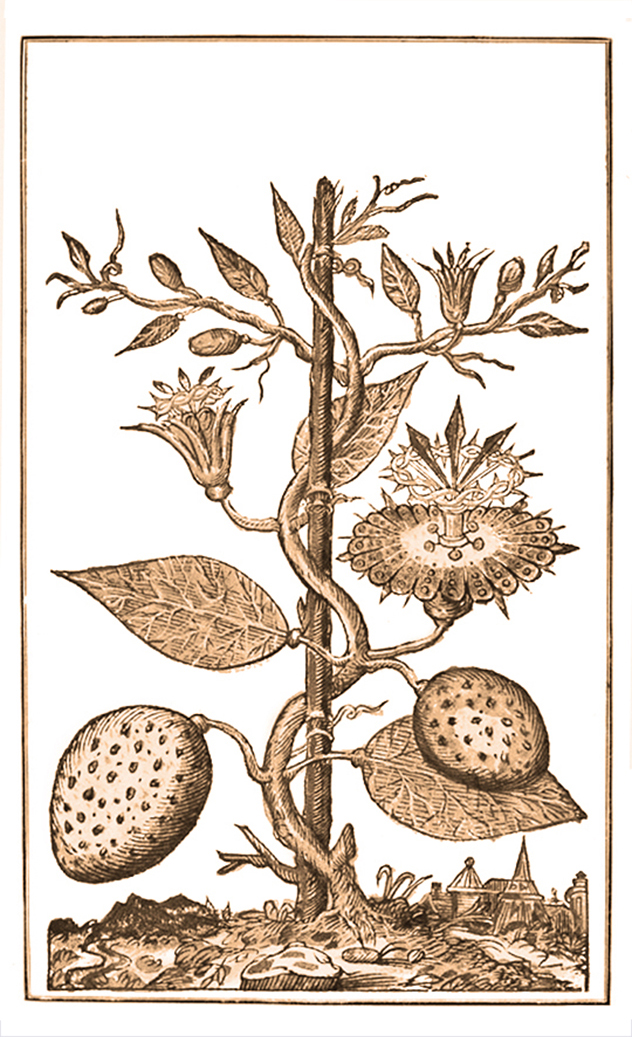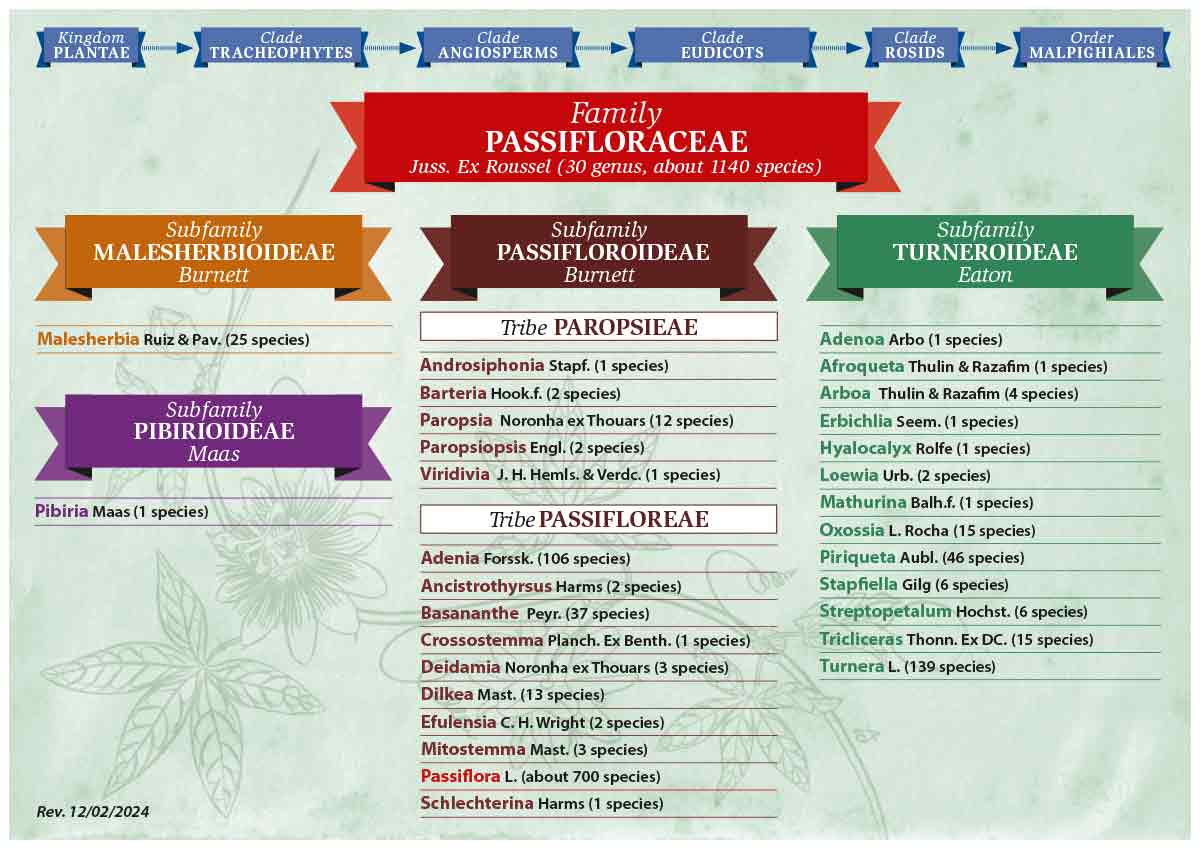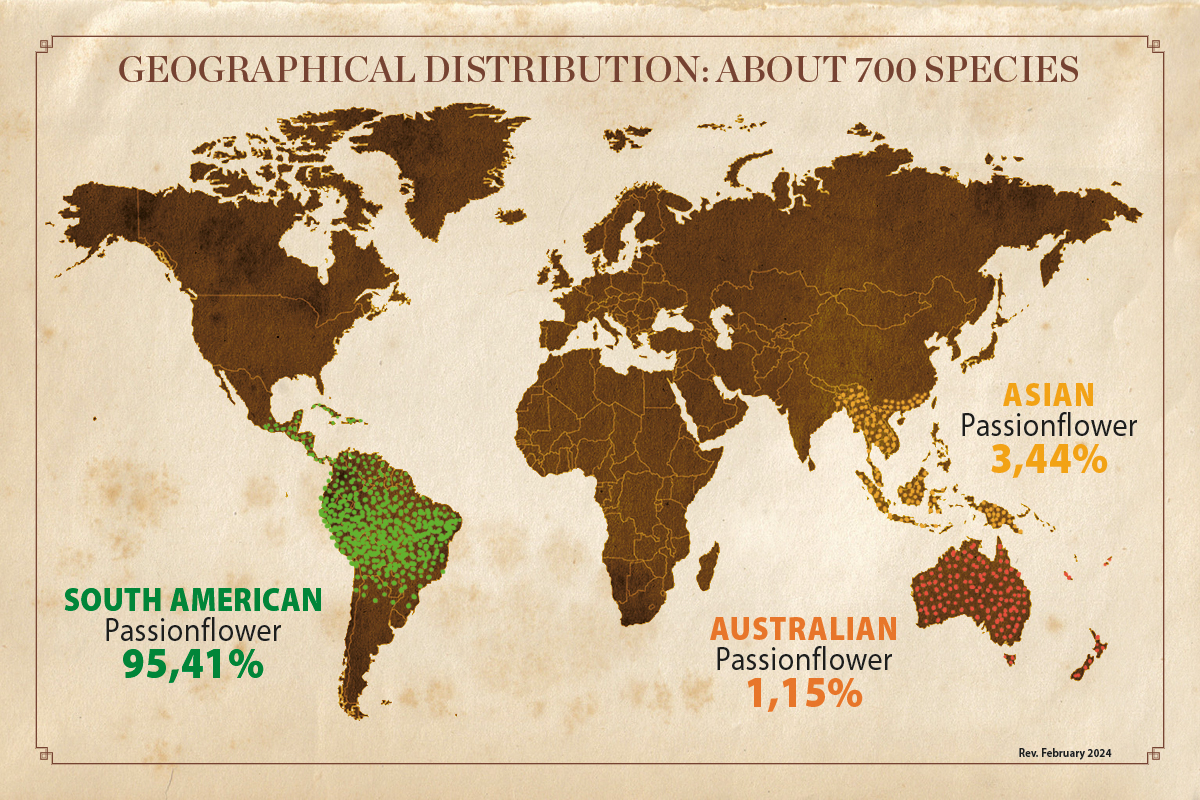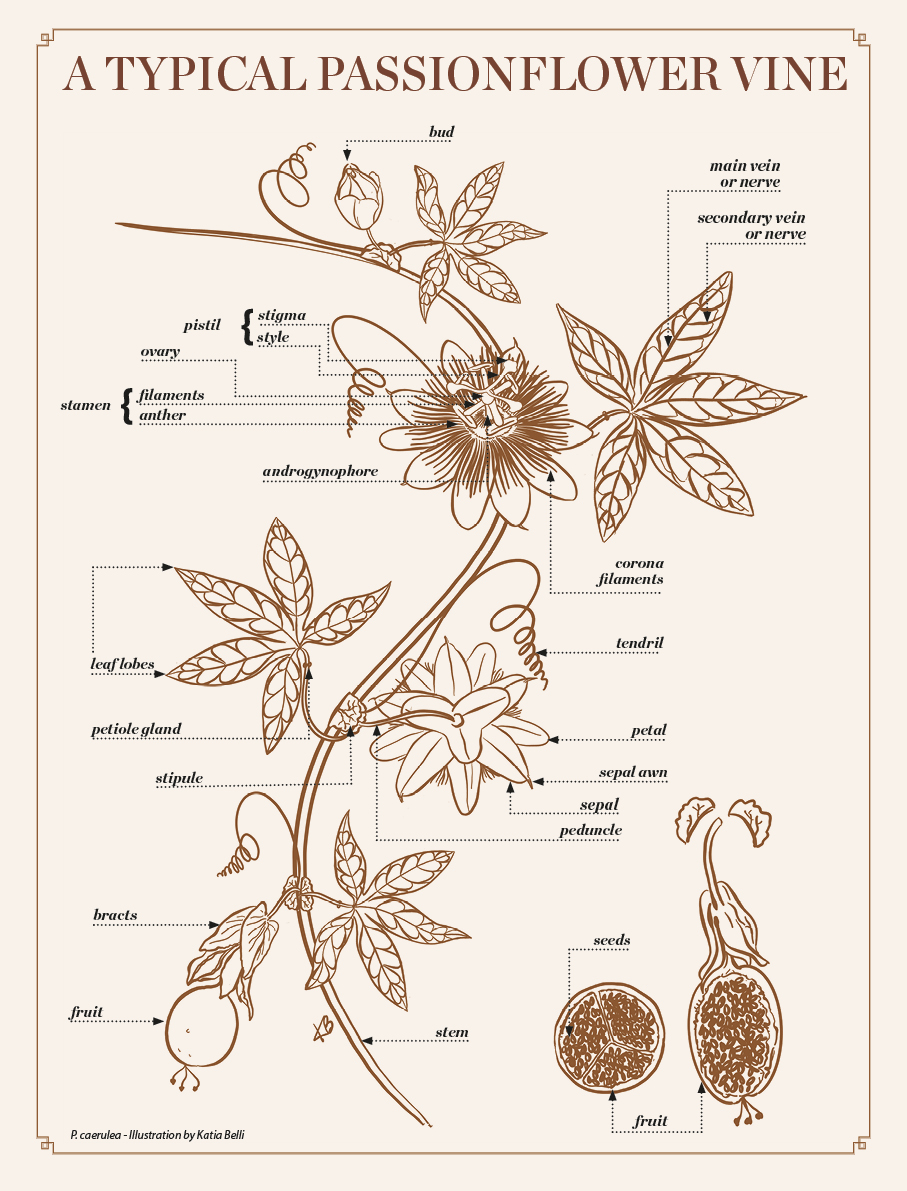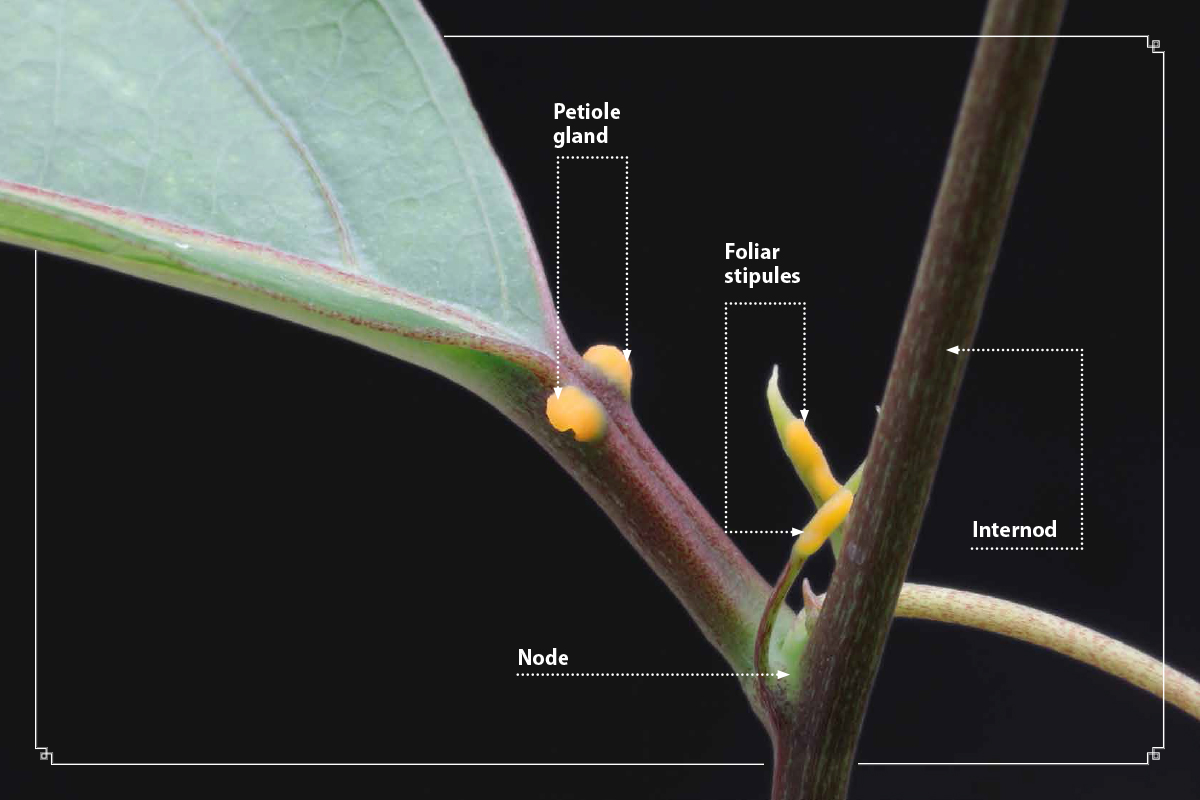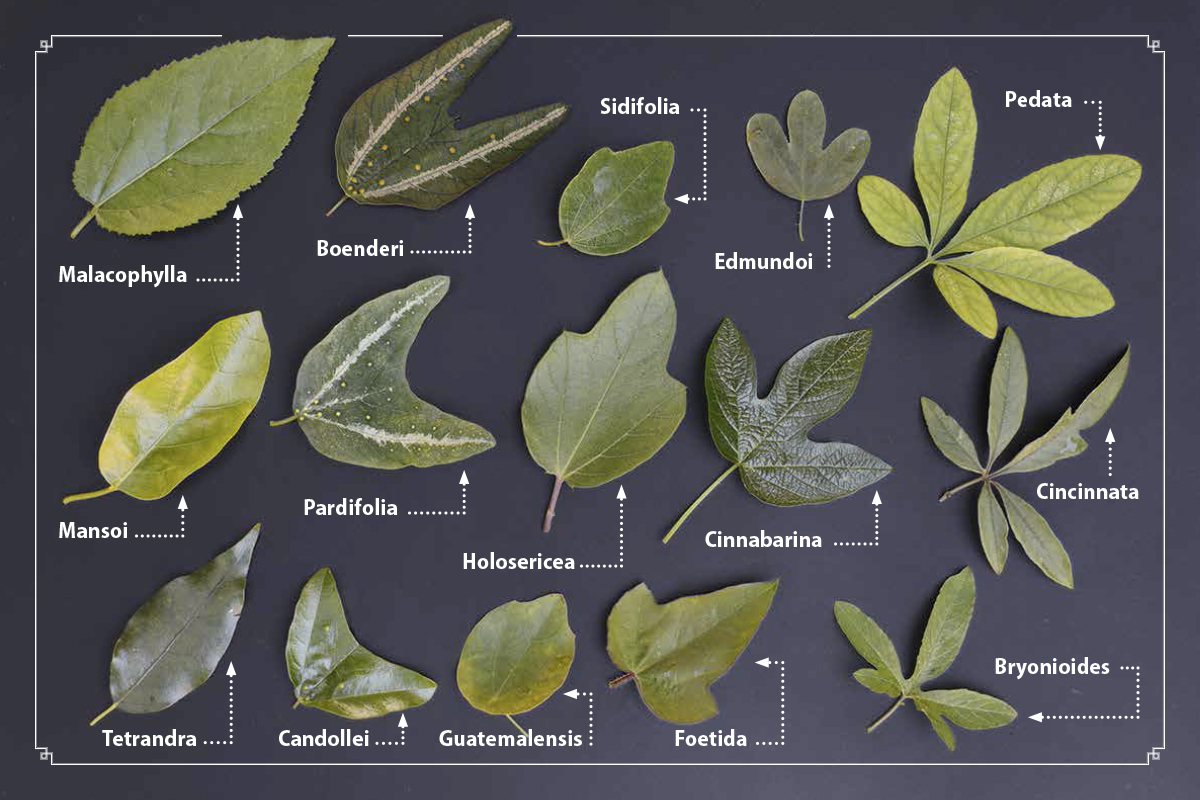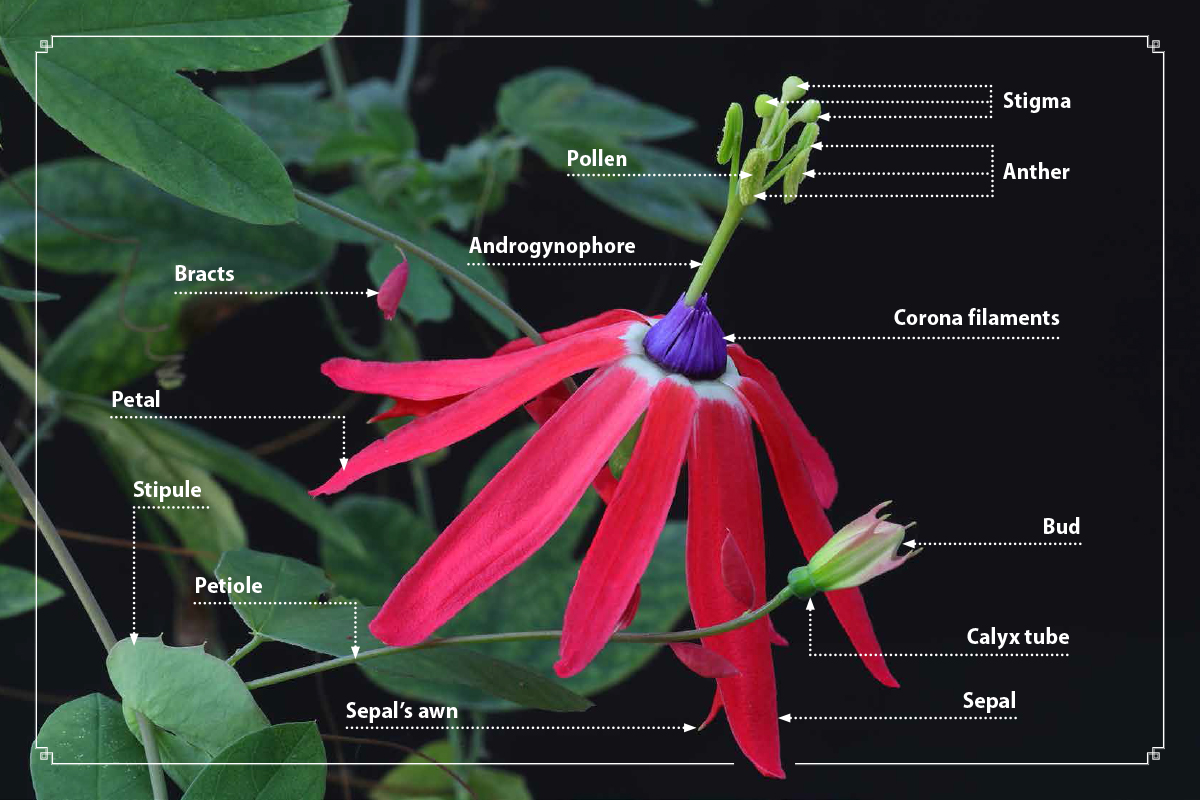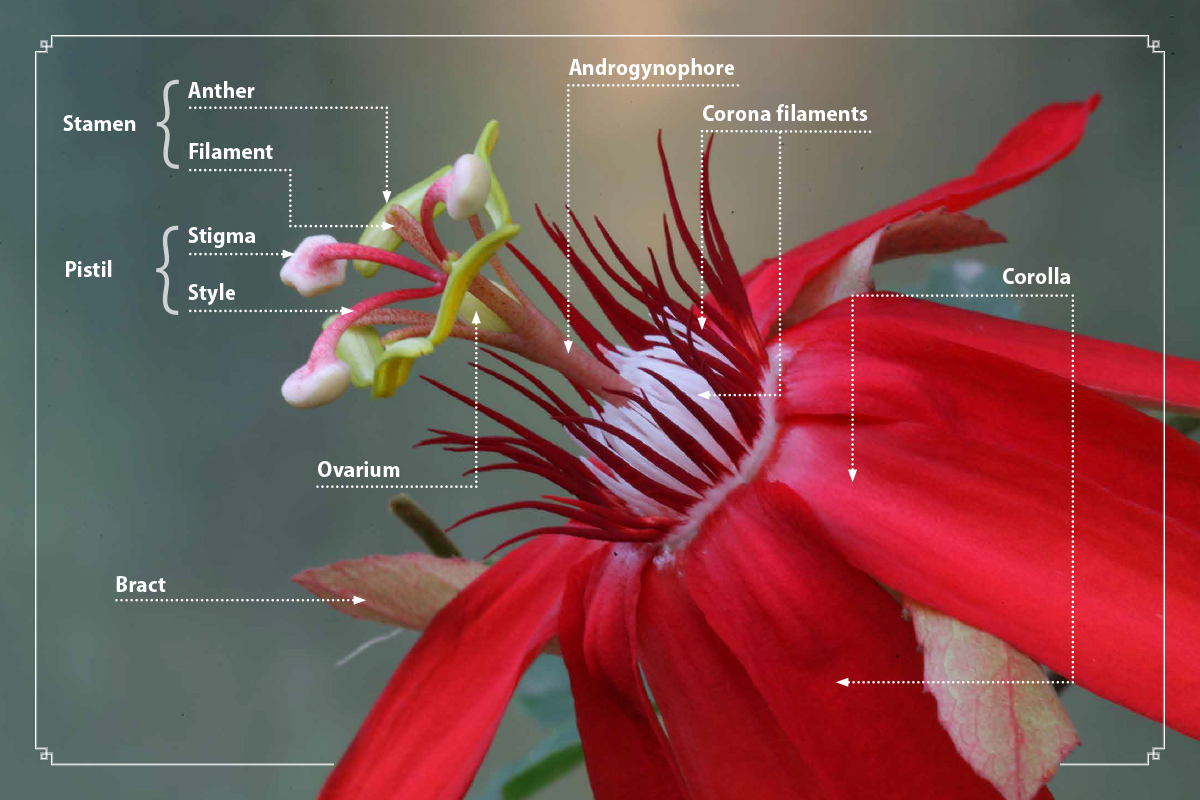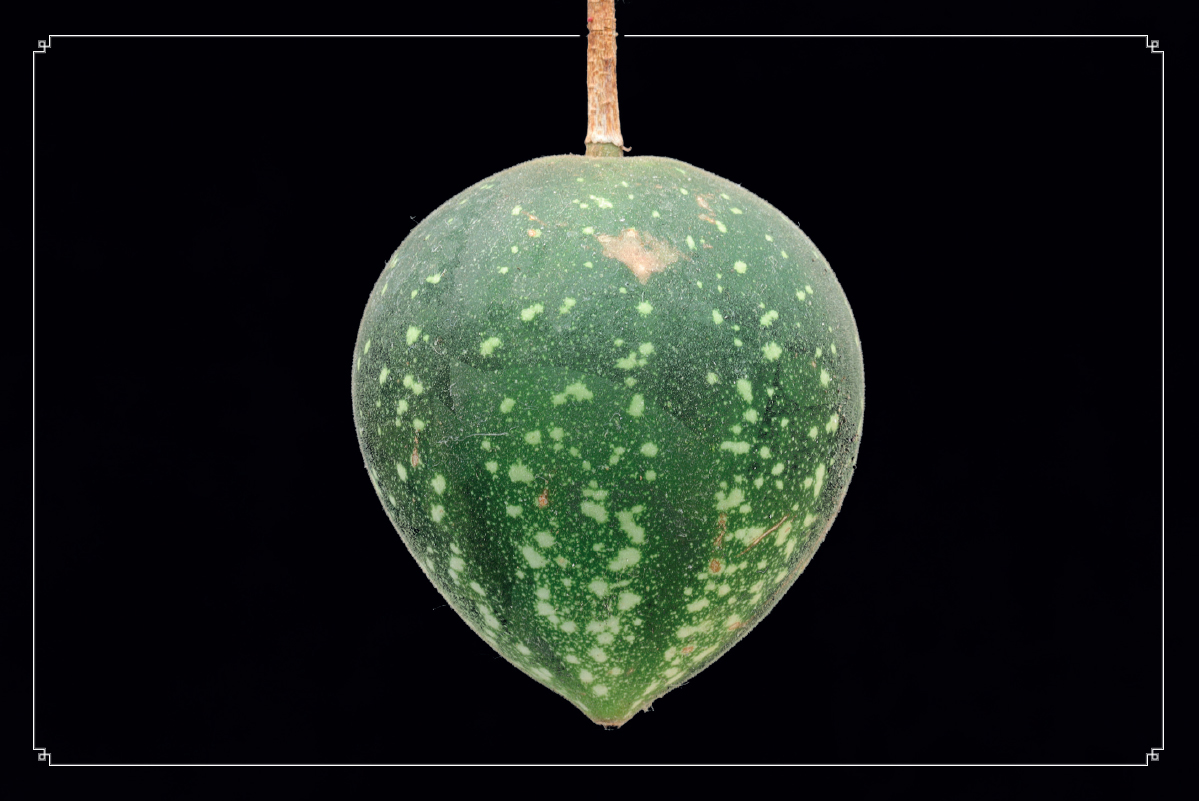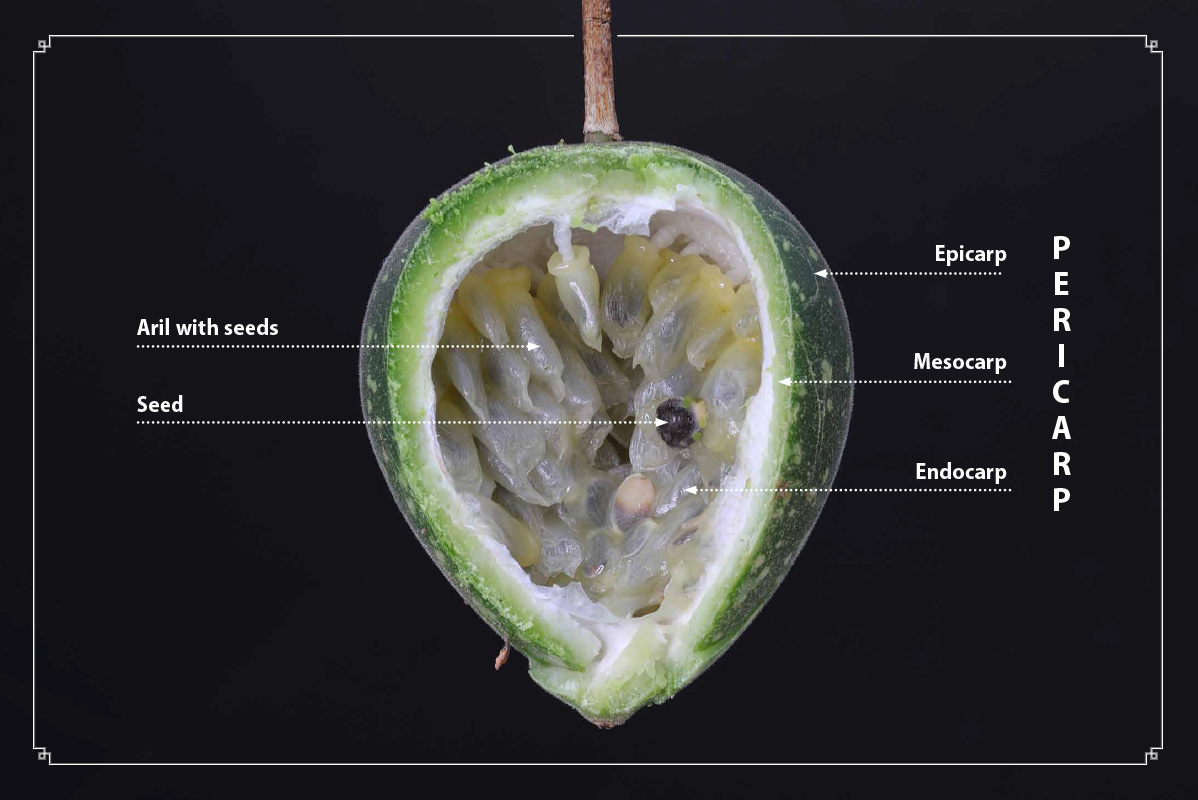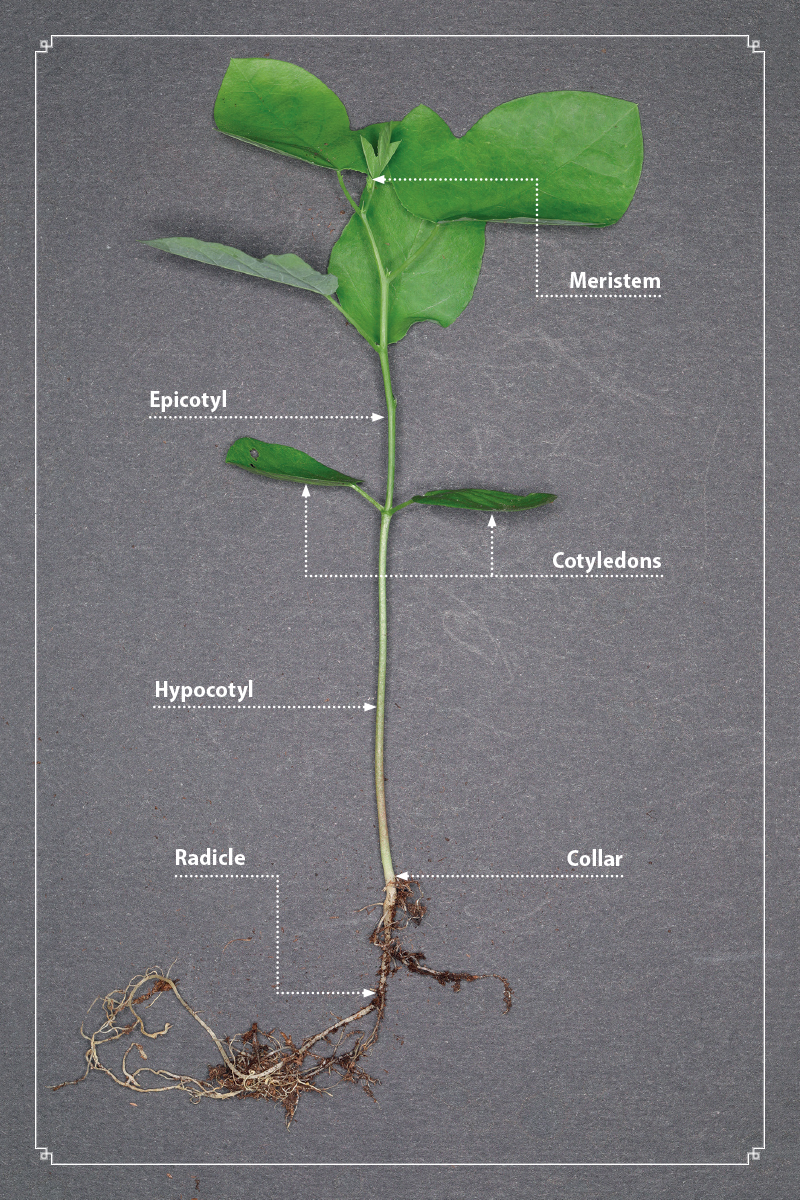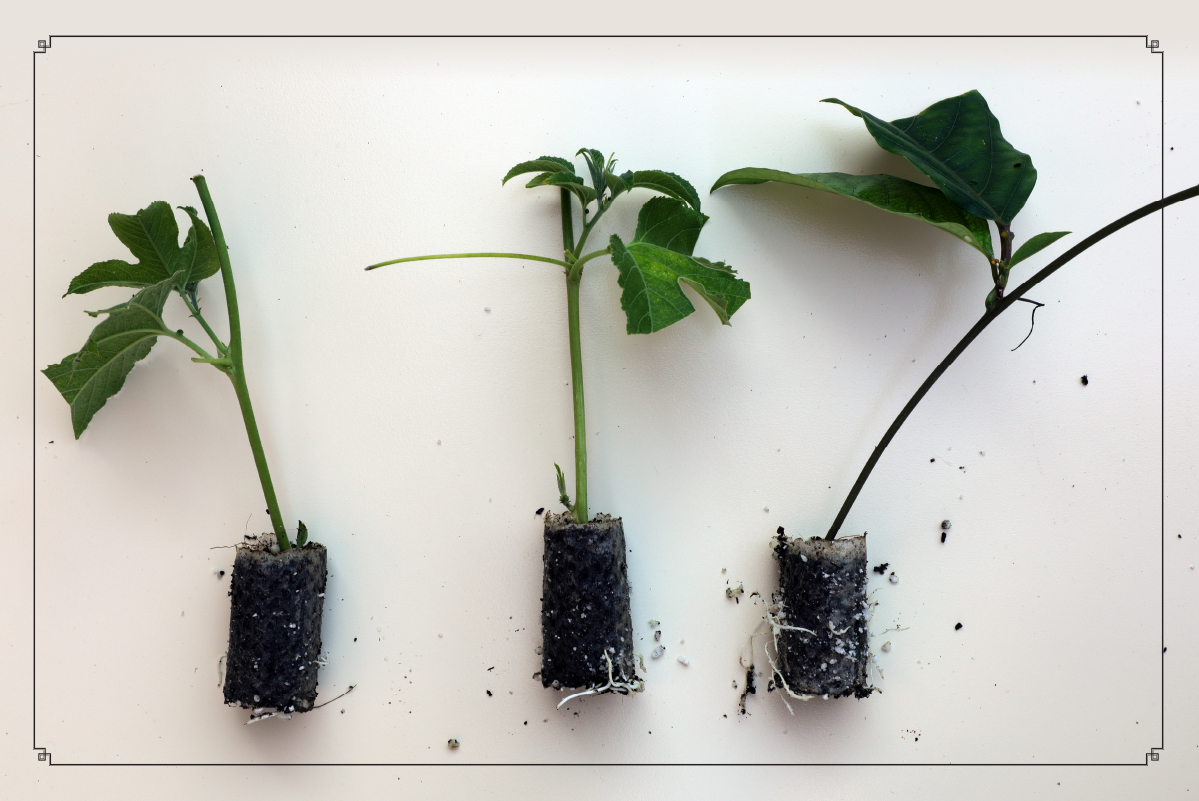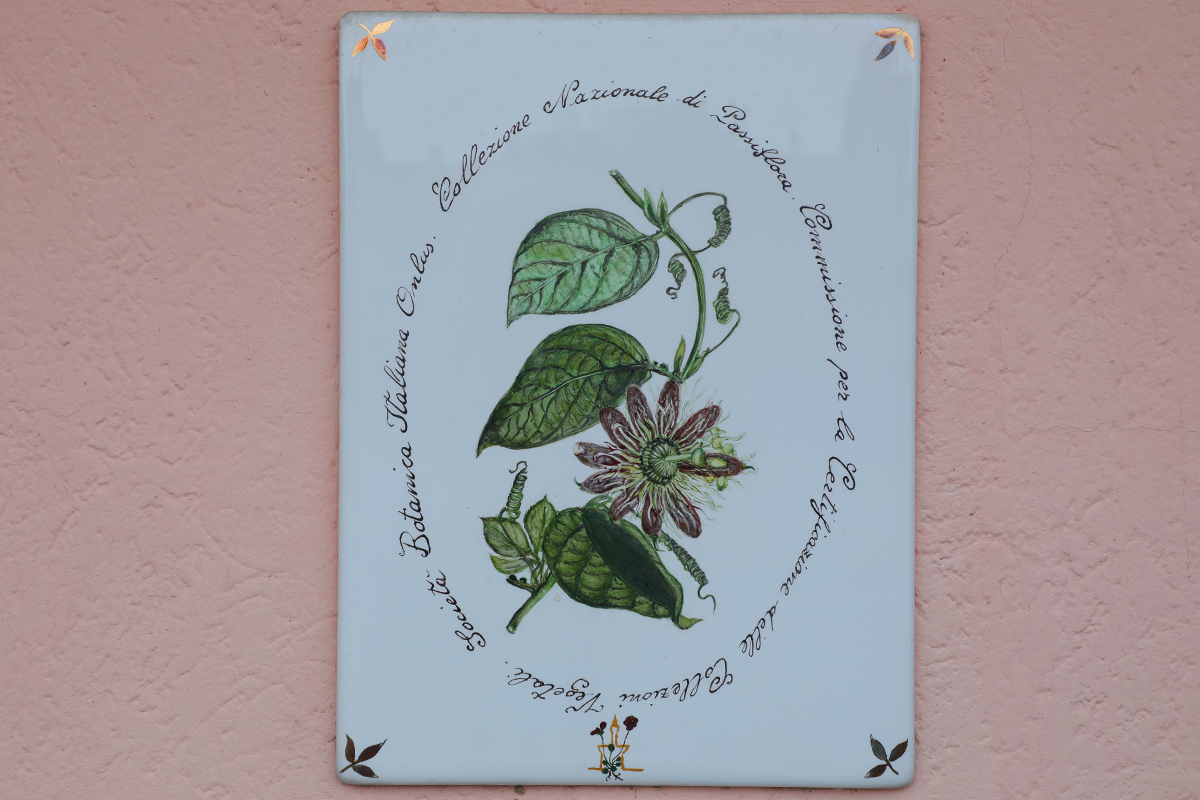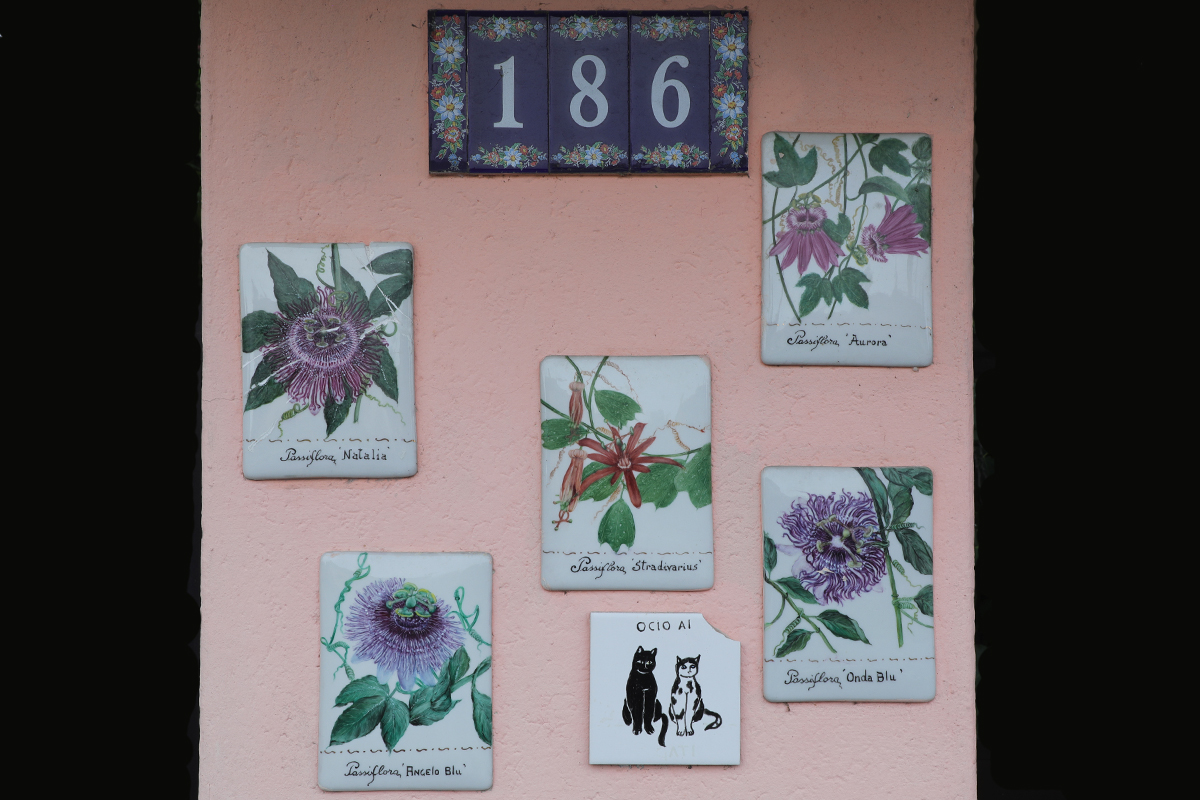INDEX
1) THE DISCOVERY OF PASSIFLORA, THE ORIGIN OF THE NAME, THE SYMBOLISM
5) Cultivation, reproduction and multiplication
1) THE DISCOVERY OF PASSIFLORA, THE ORIGIN OF THE NAME, THE SYMBOLISM
Passifloras were unknown in Europe before the voyages of Christopher Columbus. Following the discovery of the American continent (1492), they were described and brought to Europe where they were received with great amazement.
The origin of the name Passiflora can be attributed to the first missionaries who arrived in South America. They believed that the centre of the flower depicted the symbols of the crucifixion of Jesus Christ, so much so that these plants were called 'Flos Passionis'. In his work ‘Species Plantarum’ (1753), Linnaeus transformed this into the current name of Passiflora.
In his book 'I frutti tropicali coltivabili in Italia' [The Tropical Fruits Cultivable in Italy], Guglielmo Betto cites a 'Erbario o Storia Generale delle piante' [Herbarium or General History of Plants] by Pietro Antonio Michiel (Venice 1510-1576), published between 1553 and 1565, in which the Passiflora is mentioned, already then present in Italy in the Botanical Garden of Padua.
In 'La trionfante e gloriosa Croce, Trattato di Iacomo Bosio' [The Triumphant and Glorious Cross, Treatise of Iacomo Bosio] of 1610, friar Father Iacomo Bosio (Chivasso 1544 - Rome 1674) described and depicted (page 162) the symbols of the passion of Christ recognised in its flowers. According to tradition, the 3 nails are represented by the 3 stigmas; the crown of thorns by the crown of the filaments; the 5 petals and the 5 sepals symbolise the 10 apostles who remained faithful to Jesus Christ; the androgynophore recalls the column of the flagellation and the tendrils, obviously, represent the scourges; finally, the 5 anthers are the 5 wounds. Legend recounts other imaginative and suggestive analogies.
Numerous writings and representations can be found in illustrated treatises and herbaria of the 16th and 17th centuries. I cite the Badianus Manuscript, a handwritten herbarium from 1552, a Latin translation of the Aztec herbarium (Libellus de medicinalibus indorum herbis), and the work 'Nova Plantarum, Animalium et Mineralium Mexicanorum - Rerum Medicanorum Novae Hispaniae Historia' in which a passiflora with bilobed leaves, called 'Coanenepilli' in Aztec language, is illustrated.
There are Christological representations and descriptions in Simone Parlasca (Il fiore della Granadiglia, overo della Passione di Nostro Signore Giesù Christo, 1609), Pedro Cieza de León (La chrónica del Perù, 1553), Eugenio Petrelli (drawing on the title page of the work by Antonio Possevino 'Cultura ingeniorum', 1610), Johann Zahn (Specola physico-matematica-historica, 1696), John Parkinson (Paradisi in Sole paradisus terrestris, 1629), Josè de Acosta (Historia natural y moral de las Indias, 1590), Antonio Canali, and others. Many writings refer to the Passiflora, often called Granadilla sive Flos Passionis, Flos de cinco llagas and, in Amerindian terms, maracuja, maracock or maraco.
French monk Charles Plumier (Marseille 1646 - Cadiz 1704) published realistic drawings of many passifloras discovered during his expeditions in his work ‘Description des plantes de l’Amerique’ (1693). Thanks to his knowledge of botany and excellent graphic technique, he was appointed court botanist by King Louis XIV and sent to the Antilles to describe the species encountered. He made precise tables depicting new passifloras which he called Clematis indica, Clematis of the Indies, due to their vague resemblance to Clematis themselves.
In 1609, Jacopo Ligozzi, a Florentine painter, also painted this panel depicting a passiflora.
The prints drawn during the Royal Botanical Expedition to New Granada (present-day Colombia) by José Celestino Mutis (Cadiz 1732 - Bogotà 1808) are beautiful. This expedition was organised with the approval of the King of Spain Charles I and successive rulers. It began in 1783 and lasted until 1816. Josè Celestino Mutis made use of numerous collaborators, artists and botanical designers. About 20,000 species of plants and 7,000 animals were described and illustrated.
Starting in the 1950s, these accurate botanical drawings, with precise morphologies and an elegant aesthetic, were published in 37 large volumes (Tomos) measuring 54 x 38 cm. Tomo XXVII in my possession is entitled 'Passifloraceas y Begoniaceas'. 40 passifloras are illustrated in 42 plates.
Many botanically perfect passiflora
drawings are also present in Curtis's Botanical Magazine and in
other ancient and more recent publications.
2) Systematics
In the universally accepted botanical classification of Dicotyledons, the genus Passiflora is ascribed to the Passifloraceae family, which in turn are included in the order of Malpighiales.
The Passifloraceae family contains over 750 species divided into 27 genera. It includes the Malasherbioideae, Passifloroideae and Turneroideae subfamilies. Within the Passifloroideae subfamily are ascribed the Paropsiae and Passifloreae tribes. The Abatiae tribe has recently been excluded and ascribed to the Salicaceae family. The Passifloreae tribe includes these genera: Adenia, Ancystrotyrsus, Basanthe, Crossostemma, Deidamia, Dilkea, Efulensia, Hollrungia, Mitistemma, Passiflora and Schecheterina.
Among these, the genus Passiflora is the most important and numerous. Alone it includes over 600 species, almost all of which have a climbing and liana-like posture, but there are also bushes, trees and perennial and annual herbaceous plants. Experts still disagree on a correct and definitive classification for some species. Meanwhile, new species have been discovered, even recently. In inaccessible areas of the Andes or in unexplored forests there may be some waiting to be identified.
Hybrids abound thanks to the high number of species that can be easily combined with each other. Exceptionally beautiful plants have been obtained in this way.
Ellsworth Killip, writing in his 1938 publication (The American Species of Passifloraceae), divided the Passiflora genus into 24 homogeneous groups called Subgenera, in turn divided into Sections and Series. In his important text, the author had the merit of bringing together numerous genera, such as Disemma, Murucuja, Tacsonia, etc. in the genus Passiflora itself. In Angiolo Pucci's remarkably interesting work published by Ulrico Hoepli, ‘Dizionario Generale di Floricultura’ [General Dictionary of Floriculture] (Milan, 1915), passifloras were still divided into the other names, now abandoned.
The systematics are therefore complex, and this is due to the large number of species that have evolved, differentiating in various directions. Recently (2004) the classification was revised by John MacDougal and others: this replaced that of Ellsworth Killip, merging many of its Subgenera into just four major Subgenera: Astrophea, Deidamioides, Decaloba and Passiflora, subdivided in turn into Supersections, Sections and Series.
These are therefore the categories of the subdivision of the genus Passiflora established by international convention: Family, Tribe, Genus, Subgenus, Section, Series, Species, Subspecies, Variety, Form.
3) GEOGRAPHICAL DISTRIBUTION
The geographical origin of most passifloras is central-southern America, in particular the vast tropical and subtropical areas ranging from the Andes to the coasts of the Atlantic Ocean.
Nations rich in these plants are: Brazil, Venezuela, Costa Rica, Nicaragua, Guatemala, Colombia, Ecuador, Bolivia, Mexico, Guyana, Peru, Paraguay, Argentina, Honduras, Jamaica, etc. Some species, in more limited numbers, are instead North American (United States), Australian and Asian.
These climbing plants were imported to Europe in the first half of the 17th century. Among them, in particular, P. caerulea has naturalised in various locations on the Italian peninsula, especially in the central and southern areas.
In addition to the American species, there
are 21 Asian species (China, Borneo, India, Papua New Guinea, Thailand,
Vietnam), 5 Australian species, one in New Zealand, one in Fiji and one in the
islands of Samoa, all ascribed to the subgenus Decaloba, except P.
tetrandra which is associated with the subgenus Deidamioides.
4) MORPHOLOGY
Passiflora flowers have characteristics and structures that are unique in the plant world and are highly appreciated for their undoubted elegance. Thanks to their vibrant filaments they recall the beauty of fireworks.
They have nothing to envy in the most spectacular flowers, nor do they lack variety of shapes and colours such as to consider them unique. In addition, they produce excellent fruit and give us decidedly pleasant fragrances. In many species, their leaves often have unusual shapes and picturesque colourings. It seems almost that the genus Passiflora possesses something superior to other plant families, as if a more advanced evolution had taken place. Among others, they have been able to develop intense and particular relationships with other living beings: insects, hummingbirds and bats.
Observing these vibrant climbing plants carefully, one is amazed by the multiplicity, diversity, extravagance and art of the various structures: flowers, fruits, leaves, etc.
The flowers are usually hermaphroditic, axillary and solitary, rarely united in pairs (P. biflora) or in racemes (P. racemosa). The sizes vary from the very small flowers of the P. suberosa (5/6 mm) to the large flowers of the P. quadrangularis (12/15 cm) and P. speciosa (over 15 cm).
Starting from the flower peduncle, which normally originates along the stem at the axil of the leaves, three bracts meet. Sometimes they are large, vivid and of a colour that contrasts with the flowers, often they come with particular nectar glands. P. foetida, for example, has large filamentous and finely divided bracts: a true embroidery. The position and shape of the bracts is an important identifying element for attribution to a specific subgenus.
Then follows the calyx of the flower which supports the sepals, petals, crown of filaments and column of the androgynophore bearing the ovary, anthers and stigmas. The shape of the tubular calyx is different in the various subgenera: for example, it is very elongated in the Tacsonia Section of the Subgenus Passiflora and shorter in others.
Within it, in many species, there is the nectar ring and it is here that the androgynophore originates. At the base of the latter there is the limen which, counterposed to the operculum of the corona of filaments, in the species that are provided with it, closes the cavity of the calyx.
The column of the androgynophore continues up to the five filaments that carry the pollen-producing anthers. The filaments and anthers form the stamens. This is followed by the ovary which, fertilised by pollen, is destined to swell until it becomes fruit. The flower ends with the three styles bearing the stigmas which are the pollen receptors. The styles and stigmas form the pistils.
Externally, the calyx continues in the five sepals, almost always characterised on the lower lamina by an external strengthening keel and an apical spur. They are usually green, with a robust ribbing in the lower part and a colour similar to that of the petals in the upper part. The 5 petals, alternating with the sepals, complete the corolla of the flower. They are almost always very vivid, larger and more intense than the sepals themselves. In some species, however, they are absent or reduced, so much so that the symmetry of the flower becomes a star with five points instead of ten (e.g. P. cinnabarina).
Finally, originating from the central part of the corolla and placed above the petals is the corona of filaments. This structure, very variable in shape, size and colour within the various species, aesthetically embellishes the flower and probably has the function of exerting greater attraction for pollinating animals.
The filaments are sometimes arranged in several series, often of different lengths. They can thus surpass the petals and are often coloured in alternate bands and with colours contrasting those of the corolla, offering a decisive pictorial effect similar to concentric circles. Starting from the base, the filaments taper towards the apex and often curl gracefully (P. cincinnata). There are usually very many, reaching several hundreds. Many flowers also have an intense smell but the aroma emitted by some species, such as those of the Dysosmia Section, is not very pleasant and a little annoying.
The fruits of the Passiflora, which originate from the ovary, are normally berries, formed by a light, almost papery integument, coloured yellow, purple, blue and black when ripe, or elegantly streaked with yellow and green. The shape is ovoid or elongated. In some cases, however, it is a capsule which, when ripe, opens spontaneously in pre-established fracture lines (P. capsularis) to release the seeds. The sizes range from small fruits such as the pea-sized berries of P. suberosa, P. boenderi and others, to large fruits such as those the size of a turkey egg of P. quadrangularis and P. trialata. The inside of the fruit consists of a gelatinous pulp (aril) containing the seeds. Many passifloras produce edible fruits, delicate in flavour and aroma, so much so that some species are cultivated industrially (P. edulis).
The seeds of the passiflora are flat, heart-shaped, dark, with a hard and wrinkled cuticle. They normally measure less than 1 mm to 4-5 mm in length.
The leaves of the passiflora, alternating along the stem, are very variable in shape, texture, size and appearance. They range from the simpler ones, with a single lobe, normally lanceolate (P. laurifolia), to those that are bilobed (P. capsularis), sometimes transverse (P. coriacea) and those with a greater number of lobes but always in odd numbers, i.e. 3, 5, 7, 9, etc. (P. incarnata, P. caerulea, P. cirrhiflora).
Only in some species is it possible to see leaves of variable and anomalous shape (heterophyllia), occasionally with four lobes, as I happened to see for example in P. seemannii. Their size varies from a few millimetres (P. gracillima) to about one metre (P. macrophylla). The leaves are normally provided with stipules at the attachment of the petiole to the stem. In some species the latter are also uncommon, having deeply serrated margins (P. hahnii, P. guatemalensis) or unusual shapes (P. foetida).
The petiole of the leaf has nectariferous glands or nectaries (glands of the petiole), arranged in pairs and in variable numbers. Sometimes they are barely apparent, sometimes quite evident and protruding, filiform or even supported by short peduncles (P. adenopoda). Their position, their shape and their number are important identifying elements. In fact, often apparently identical species can be distinguished precisely by the differences in the glands of the petiole or by their number.
Nectariferous glands, often yellow, are also present on the leaf lamina (leaf glands) of many species of Passiflora, on both the lower and upper lamina. Sometimes they are symmetrically arranged and are aligned along the main vein of the leaf, or they run along secondary veins and have contrasting colours with the dominant hue of the leaf blade. They too contribute to increasing the aesthetic interest of passifloras as well as making these plants very curious. Passifloras can have coloured leaves, with yellow bands (P. trifasciata, P. apetala, P. boenderi, P. pardifolia), reddish bands (P. organensis marmorata) or with light green marbling (P. coriacea). The leaf glands and those of the petiole produce brilliant droplets of very sweet nectar which attracts ants in particular.
In climbing species, as well as flowers, there are tendrils at the axil of the leaves. They have the amazing ability of quickly winding around everything they touch.
In some species (P. discophora, P. gracillima) they are branched and endowed with small disks similar to suckers at the ends, suited for adhering to the bark of the large trees that support them. In rare cases, in some species ascribed to the subgenus Astrophea, for example P. spinosa, P. rusbyi, there are small thorns at the node of the stem. They are soft and actually harmless.
As often in climbing species, the stem is thin, sometimes hollow, with a round section and green in colour. In some species it has a square, triangular or polygonal section. In old specimens the base of the plant is covered with bark. When they grow outdoors, the most robust species reach considerable lengths and are abundantly branched, so as to form a thick and suffocating curtain of leaves.
The root system is proportionate to the size of the climber and fasciculated. Sometimes the roots are fleshy and emit root suckers around the mother plant (P. caerulea, P. incarnata, P. 'Fata Confetto'). Some species produce swollen (P. cirrhiflora) or tuberous (P. tuberosa) roots.
The plants are also extraordinary biological laboratories. Their cells are capable of synthesising thousands of complex substances.
They are the secondary metabolites.
They have various functions, including protection from insects, herbivorous animals and pathogens. To defend themselves from oxidative processes they have developed antioxidant molecules. These metabolites also serve to attract pollinating animals (attractiveness signals) and spread their seeds. For this purpose, the plants produce pigments of all colours, fragrant, sometimes smelly volatile substances and compounds that give a pleasant flavour to the fruits.
Many medicinal substances we use come from
these secondary metabolites. The sedative and tranquilising properties of P.
incarnata are well known. In 2008, Prof. Flavia Guzzo (University of Verona) tested some extracts of P.
nitida, P. palmeri and other species. Some of these extracts have
shown antibiotic, antioxidant and anticancer activity in vitro. I hope that
studies and research will be conducted again to discover therapeutic properties
in the various species of passiflora.
5) Cultivation, reproduction and multiplication
In order to create a good collection with the most interesting and beautiful plants, you need to have a small heated greenhouse with a minimum winter temperature of at least 10°C. In the various climatic zones of Italy, with cold winters, it will only be possible to cultivate a limited number of species and hybrids in the garden. The presumed minimum and ideal temperatures are indicated in each passiflora fact sheet on this site.
Resistance to cold (fridge-resistance) is a genetic characteristic of each species, indeed of each specimen. In many species, there are genes that express cold-protecting proteins. In others they are absent or scarce. We have all verified that fridge-resistance is also possible in tropical species, typical of the warm climates of our planet. This should not be surprising. Many of these lived and evolved in ancient times in regions subject to the long ages of glaciations and for this reason they codified this memory in their genetic code.
When the warm season arrives, it is advisable to take the delicate passifloras grown in pots and sheltered outdoors, providing them with adequate support, so they will bloom and bear fruit better, especially starting from the month of June. Some of them (P. quadrangularis, P. alata) are late-flowering and wait for the end of August to show their extraordinary beauty which is in no way inferior to that of exotic plants; spectacular yes, but more critical. There are passiflora that are suitable as houseplants and bloom regularly indoors.
You can find flower pots of P. caerulea and pretty hybrids such as P. x violacea or P. 'Incense' at nurseries. Lovers of exotic and tropical butterflies of the genus Heliconius grow passifloras to raise the caterpillars of these stupendous moths. These insects in fact have a particular predilection for plants of the genus Passiflora and the beauty of the flower goes well with that of the butterfly.
It is very easy to reproduce passifloras, perhaps easier and faster the agamic way (cutting, grafting, using offshoots, etc.) than by seeding. Cuttings root quickly if kept in a small, highly humid, warm and bright environment, such as a glass box, which is an indispensable system for conserving and multiplying hybrids. Preparing the cuttings is simple. The practice involves making binodal cuttings. Take a healthy and robust portion of stem. It is cut 2/3 cm below a node that bears the leaf. The leaf is removed. It is then cut a few centimetres above the next leaf, and this is the second node. The leaf is cut in half to reduce transpiration. The cutting is ready. If the material available is scarce, mono-nodal cuttings can also be made using the same technique described above. Jars containing a substrate made of blond peat and perlite in equal parts are prepared or commercial soil is used for cuttings and sowing. The cuttings should be treated at the base under the lower node with rooting hormone. Both indole-3-butyric acid (IBA) and alpha-naphthalenacetic acid (NAA) are used.
There are both liquid (for example Clonex) and powder (for example Germon and Rizopon) hormones on the market. In my experience, the most active hormone for passifloras is indole-3-butyric acid (IBA). The cuttings should be dusted with the rooting powder and shaken slightly to remove excess, or immersed in the rooting liquid according to the manufacturer's instructions. They must be inserted into the jar so that the lower node is immersed in the soil. They are then watered. The jar should be placed in a closed place, kept warm (about 25°C) and humid. The ideal is an environment equipped with a fog system. Alternatively, it is useful to spray the cuttings regularly with a vaporiser. To keep the humidity constant, a water-impregnated fabric carpet can be used. Base heating then makes the difference. There are 18-20 W heating panels on the market that can be placed under the mat where the cuttings are placed. Under these conditions, humid environment and heated base, the cutting will quickly emit roots and develop a shoot with leaves at the top node. The seedling is left to consolidate and then replanted in a larger pot.
Sowing, on the other hand, sometimes gives disappointing results and germination is erratic and never rapid. Proper storage of seeds is always an essential element for success. It is necessary to exercise patience and wait a long time before seeing the desired seedlings appear. I have seen germination take place when I had decided to throw everything away.
Sowing is however the obligatory method for enriching your collection with species from far away or that are otherwise unavailable. The seeds can be easily shipped over great distances and do not suffer from transport like live plants. Before sowing it is advisable to treat them in water. Given that the integument is particularly hard, it is useful to immerse them in slightly warm water for 24 hours. Many useful techniques exist for interrupting the dormancy of the seeds, a process that is formed when they do not have the possibility of entering into germination as soon as they are removed from the fruit. Some recommend lemon juice, milk, gibberellic acid (GA3), NAA and more. Pucci writes: “… it multiplies by seed and the seeds stratify in January and are sown two months later: they germinate quickly”.
Once this is done, the seeds are placed in jars containing soil for sowing, also self-prepared (blond peat and perlite). I sterilise it in a microwave oven to avoid the presence of midges eggs which would produce harmful larvae and mould spores such as Bortrytis, Phytopthora and Pythium. The ideal temperature for germination is around 25°C and an environment high in humidity is also necessary in this case. The soil should always be kept moist, but not soaked. Germination will take place on average no earlier than 10/15 days. Cotyledons will appear and subsequently the apical bud will develop the stem with the real leaves. It is good to let the new-born seedlings grow until they have reached a height of 15/20 cm before repotting them individually in larger pots.
You can find more information here.
Adult plants should be grown in well-drained universal soil due to the presence of inert substances and at a subacid pH. As these are climbers, pots with a diameter of at least 15 cm must be fitted with canes to allow the tendrils to cling. You can use sticks placed in a pyramid shape, lattice-shaped trusses or other system. Those in the ground fit well on mesh fences or trellises.
Fertilisation should be carried out regularly with Osmocote-type products for flowering plants, which guarantee constant and lasting fertilisation. Alternatively, regular fertigation is useful, usually weekly, with products containing a balanced composition at the beginning of new vegetative growth, (for example Grow More NPK 19-19-19) and subsequently with products for flowering plants which are richer in phosphorus and potassium as well as nitrogen (e.g. Grow More NPK 9-15-30). These products are also suitable and recommended for foliar fertilisation.
It is essential that these fertilisers contain micro and trace elements (Magnesium, Copper, Zinc, Iron, Boron, Manganese and Molybdenum), which are essential for the biochemical cycles of plants.
A nursery friend of mine uses soil made up of blond peat, brown peat, zeolite, or pumice with 15% clay and NPK 12-12-17 base fertiliser. During the summer, add potassium sulphate weekly (2 grams per litre) to encourage flowering. Its passifloras are extraordinarily luxuriant with flowers.
Passifloras are generally resistant to numerous parasites and fungal diseases common in other plant species. Critical issues are due to attacks by scale insects, both mealy bugs and shield lice (half a peppercorn), mites and thrips. There are currently adulticidal, larvicidal and ovicidal products on the market which, if used correctly following the instructions, quickly solve these problems. Small attacks can be treated mechanically with jets of water or, for scale insects, with cotton buds soaked in alcohol. Root nematodes form galls at the roots and can lead to plant death. There are currently excellent nematocides on the market.
Excessive irrigation can compromise the
root system promoting rot. It is therefore important to limit this to what is
strictly necessary, watering only when the soil is almost dry. In any case,
very effective systemic fungicides are available (Previcur Energy).
6) PASSIFLORAS IN THE VARIOUS ITALIAN CLIMATIC ZONES
Thanks to its variety of climatic zones, which include even those that are subtropical, the Italian peninsula is certainly privileged compared with other European nations, so much so that a greater number of species could be acclimatised outdoors without difficulty. They are not plants where cultivation requires the hand of specialists because they are adaptable, generous and reward those who own them. Their variety is such that all tastes can be satisfied.
The hardier passifloras are therefore suitable for being grown in the ground, but they all grow very well even in appropriately sized pots. Naturally, in areas where there are frequent and prolonged winter frosts (Po Valley, etc.), the pot is an obligatory choice for most species. Three climatic zones are known: the phytoclimatic zones of Pavari, the zones of Köppen and those of U.S.D.A. Effectively, the first two have been abandoned. I will therefore refer to the last one and its map that you can see on this site.
It is also necessary to consider the microclimate of the location where you want to plant outdoors. Sometimes, even in a cold climatic zone, there are more suitable positions due to the possible protection of walls or other artifices. I remember that in the film The Tree of Wooden Clogs, the grandfather brought forward germination of tomato seeds by placing them close to the wall of the stable, because it was hot. He then used manure which, in fermentation, develops heat. In zones 5 and 6 it is not advisable to grow passifloras outdoors. A greenhouse is obviously needed.
In zone 7 it is possible to cultivate the hardiest species and hybrids outdoors: P. caerulea, P. incarnata, P. tucumanensis, P. x colvillii, P. lutea, P. ‘Guglielmo Betto', P. ‘Fata Confetto’. All of these are sucker-producing plants. They go to rest in the winter and emit new suckers in the spring.
In zone 8 the number of cultivable passifloras increases. P. actinia, la P. elegans, la P. urubicensis, la P. mooreana and P. umbilicata grow well, possibly with protection. All these species come from geographic areas with a temperate climate or at high altitudes.
Among the hybrids, all combinations between P. incarnata and P. cincinnata: P. ‘Incense’, P. ‘Leida’, P. ‘Vivacemente’. Also the cross-breeds with P. caerulea are endowed with good hardiness, for example P. 'Anemona'. With appropriate protection, P. ‘Amethyst’ and P. x violacea can also be tried in climatic zone 8B. I do not recommend vivid passifloras such as P. vitifolia, P. alata or P. x decaisneana.
In zone 9 the possibilities increase exponentially. Therefore, you are spoiled for choice. Many passiforas can be grown outdoors. I remember seeing a specimen of P. phoenicea about 10 m wide and full of flowers in Sicily. All the species ascribed to the Quadrangulares group (P. alata, P. phoenicea, P. x decaisneana, P. 'Marijke', etc.) and all the species ascribed to the Dysosmia group, such as P. foetida, including P.amethystina which I saw outdoors at Lake Maggiore, resist. P. x belotii (Empress Eugenie) is common in gardens. Species living in equatorial areas are excluded.
In zone 10, the hottest area of the Italian peninsula, even the most tropical species such as P. vitifolia and those that live in the forests of the Amazon can be cultivated.
The plants ascribed to the Tacsonia Section of the Subgenus Passiflora
deserve a separate mention. This group of passifloras live mostly in the Andean
regions of North America. Therefore, their congenial climate is mild, but cool,
with little temperature range. In climatic zones and in seasons with excessive
heat they hardly survive. I have never had any luck with them. In the summer
they inevitably die. I have had specimens such as P. tripartita var. mollissima
in splendid shape in the morning and completely wilted in the evening.
Heat above 30°C is suspected to activate lethal cryptogamic forms for the root
system. In summer these plants should be kept cool, in the shade and possibly
in ventilated areas. For example, I found that they have no problems by the
sea, even in Liguria, thanks to the almost constant presence of breezes.
7) THE COLLECTION
In this site it is possible to scroll through images and information, which I hope will be useful to all those who want to cultivate passifloras, satisfying curiosity and stimulating their interest.
This is what I have created over many years. Currently my collection, certified 'National Collection' by the Italian Botanical Society, has reached about 380 pots and is made up of at least 280 taxa.
The large number of species and hybrids available makes it advisable to create a large collection.
In this way, I hope to continue contributing to the spread of these plants, also in Italy.
